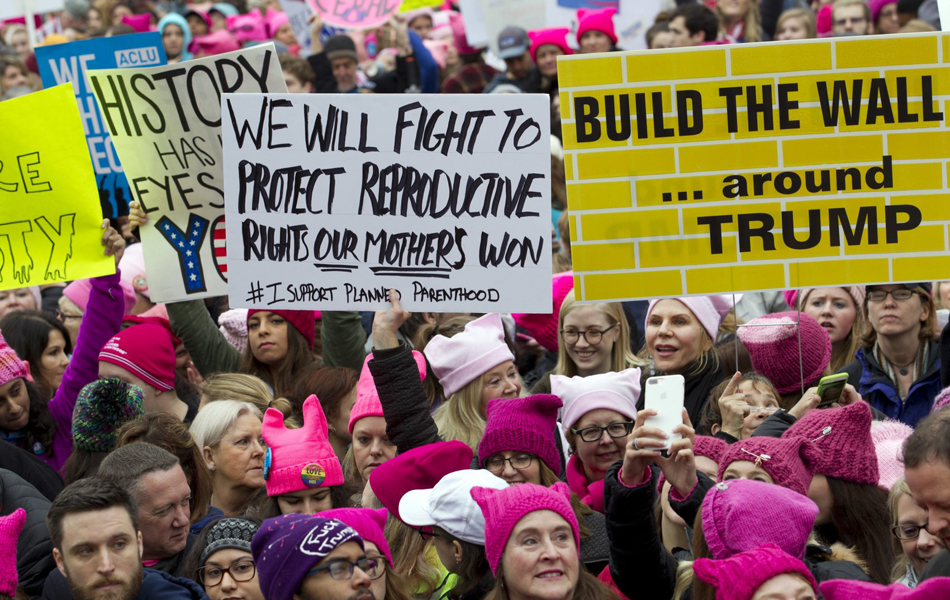
The derogatory comments and boasts of sexual assaults by Donald Trump and the multiple charges by women against him are not a new phenomenon. From the appearance of the first civilizations 7,000 years ago in Egypt, Mesopotamia, and the Indus River Valley, male supremacy has been a defining feature of class-divided society.
The widely exposed scandals involving men with power in the mass media and entertainment sectors, numerous corporations, sports, organized religion, the military, and the U.S. Congress have shown us how widespread the problem is, awakening us to something that has always existed in our midst. Sanctioned at the very top, the oppressive values of male supremacy tragically infect the whole of capitalist society. The #MeToo movement represents an historic challenge to what has been a fundamental feature of class society for thousands of years.
When force or legal authority was unnecessary to secure sexual entitlement, ruling classes could always rely on superior financial resources. Prostitution has ever flourished in class-divided societies. In ancient Egypt, Rome, and early Chinese civilization, this was frequently organized through state religious institutions (“sacred” or “temple prostitution”). If prostitution is “the oldest profession,” it is because male supremacy is the oldest form of oppression in class society.
Writing on “The Power of Money in Bourgeois Society” in his Economic and Philosophical Manuscripts of 1844, Karl Marx wryly commented, “I am ugly, but I can buy for myself the most beautiful of women. Therefore, I am not ugly, for the effect of ugliness—its deterrent power—is nullified by money.”
Super-exploitation
The basic point is that, while oppression of women (or other groups for that matter) is not directly part of the economic system of exploitation, it pervades the political, cultural, religious, and ideological superstructure that is established to enforce the system. That is, capitalism is a system of both exploitation and oppression, and humanity cannot be fully liberated until both exploitation at the economic base of society as well as all the superstructural forms of oppression are eradicated as well. The superstructure of oppression not only reinforces the underlying system of exploitation, it aggravates it and guarantees that the direct targets of oppression get even lower compensation for their labor. They are super-exploited.
For example, the Organization for Economic Cooperation and Development reports that among the 35 most developed capitalist nations, women earn 14.3 percent less than men for full-time work. In the case of the United States, the gap is wider—18.9 percent. (Wall Street Journal, Oct. 5, 2017). Super-exploitation arises from every other type of oppression, such as those based on race, sexual orientation, immigration status, etc.
The ideology of white supremacy and superiority was incorporated into American capitalism with the enactment in 1705 of the Virginia slave codes decades before the founding of our country. Racist ideology was developed at that time to justify the enslavement of Africans kidnapped for agricultural and domestic labor.
Prior to the Civil War, the U.S. Supreme Court had ruled in 1857 in the infamous Dred Scott decision that even free African Americans “had no rights that a white man is bound to respect.” Tragically, that view remains evident when arbitrary, lethal violence is meted out to African Americans by police officers and in court rulings sanctioning this behavior.
After the Civil War, racism was used to justify Ku Klux Klan terror throughout the South. It was the basis for legalized segregation and inferior wages and living conditions for African Americans and other people of color in all areas of society and throughout the country. Despite the Civil Rights victories of the 1960s, it continues to this day in subtler, but still pervasive and deadly ways.
American racism, in many respects, became the model for all the other forms of oppression that sustain the system of exploitation. But it is also U.S. capitalism’s Achilles heel, the mortar holding it together. Without racism, the whole structure would come tumbling down. The united fight of Black and white workers against racism is like the sound of Joshua’s trumpets in the battle of Jericho.
Conquest and subjugation: Midwives of capitalism
Initially, European settlers in the western hemisphere enslaved workers of all races—European, Native American, as well as Africans. Similarly, the slave empires of the Romans, Athenians, and earlier civilizations did not develop theories of racial superiority to justify slavery. Slaves were simply war captives, part of the spoils and booty of military conquest.
The conquistadors’ massacres and subjugation of the indigenous peoples of Central and South America brought with them contingents of priests to baptize survivors after looting and destroying their temples and palaces, slaughtering most of the men and raping the women. The natives were then enslaved in mining precious metals and forced to work as agricultural “peons” (serfs and indentured workers) on Spanish estates.
This amounted to the opening of the capitalist epoch. As Marx wrote in Capital, “The discovery of gold and silver in America, the extirpation, enslavement, and entombment in mines of the aboriginal population, the beginning of the conquest and looting of the East Indies, the turning of Africa into a warren for the commercial hunting of black skins, signaled the rosy dawn of the era of capitalist production. These idyllic proceedings are the chief moments of primitive accumulation…. Capital comes dripping from head to foot from every pore with blood and dirt.”
But, to overthrow feudalism in Europe and British colonialism in America, the capitalists advanced the progressive slogans of the time, proclaiming “the rights of man” and “Liberty, Equality, Fraternity.” Thomas Jefferson, who owned hundreds of slaves, stated in the Declaration of Independence that “all men are created equal” and endowed from birth with “inalienable rights,” including “life, liberty, and the pursuit of happiness.”
To square this with slavery, Jefferson and many other Founding Fathers of our country had to uphold the additional belief that Africans were inferior beings and not fully human. Jefferson’s assertion that people were endowed from birth with “inalienable rights” clearly did not apply to the six children he fathered with his slave, Sally Hemings. They were simply incorporated into his slave labor holdings.
Keeping the working class weak and divided
While racism (extending to oppression of all people of color) and male supremacy are its primary weapons, capitalism in the United States uses every other prejudice and form of division—homophobia, anti-Semitism, Islamophobia, fear of immigrants, and anti-communism—to reduce wages, intimidate and suppress the working class majority, and seriously weaken the latter’s political power.
It is a common mistake to think that racism and other forms of oppression are simply matters of personal prejudice or bigotry. These subjective attitudes are only reflections in the minds of less conscious members of the working class of the ideology of the ruling class. Prejudice is only one part of the problem. The fact is, these special forms of oppression are instituted and embedded throughout the capitalist system. They are powerful tools to divide the people in order to maintain exploitation of the entire working class. Targeted groups suffer super-exploitation, are subjected to lower wages, reduced benefits, inferior living conditions, and discriminatory treatment in all areas of society.
The effort to blame racism on white people in general only serves to divide the working class, promote racial antagonism, and divert attention from the real beneficiaries and source of the problem—the ruling class and the capitalist system.
The oppression of certain groups is not in the interest of those who are not its special targets. On the contrary, the boot of exploitation is on the entire working class, but through racism and other forms of oppression, the less exploited (e.g. white male workers) are under the sole, while the special targets of oppression (e.g. African-American and female workers) are under the heel. It is not a privilege to be less exploited and no oppressed group by itself is strong enough to lift the boot. That is why the less exploited have the urgent need and responsibility to join forces with specially oppressed groups to overcome the exploitation and oppression of all.
As Marx said, with regard to American slavery, “Labor in the white skin cannot never free itself, so long as labor in the Black is branded.”
A good example is the experience of white workers in the South after the Civil War when Black people were stripped of even the most elementary rights and subjected to a reign of terror. Whites were encouraged to be grateful that at least they were not Black. White workers gained nothing from this. In fact, their wages, working conditions, health, life expectancy, education, and public services were far inferior to their counterparts in the North. The fact that racist laws, culture, and mores prevented them from uniting with their Black brothers and sisters only benefitted the capitalists and increased their profits. Key to the special oppression of certain groups is to inculcate in those who are not its apparent targets the belief that they have an interest in maintaining this condition.
If white people had an actual interest in racism, it would be impossible to overcome because this would entail convincing white people on purely moral grounds to act against their own interest. But the fact is, racism, by dividing the working class, only serves the interests of corporate power and harms all workers—white as well as Black.
It is important for white people to understand as fully as possible the many facets and systemic nature of racism, but that is not enough. The main point is to recognize that the struggle to overcome racism requires building the maximum unity of Black, white, and all victims of oppression and exploitation to defeat the common enemy of monopoly capitalism.
The ruling class also promotes the idea that its discriminatory values and practices derive from “human nature” and that there’s nothing that can be done about it. In fact, they are values that only arose historically to justify and sustain class exploitation. Classes, class exploitation, and the special oppression of certain groups are relatively recent developments in the million years that human beings have walked the earth.
In summary, capitalism is a system in which the capitalist class exploits the working class and funnels the vast wealth created by the workers into the hands of a tiny group of billionaires. The system survives because the capitalists have vast resources to bribe underlings and the capitalist state controls the decisive means of coercion. The system also uses every form of oppression, especially racism and male supremacy, to divide and disempower the working class.
This article is an excerpt from Rick Nagin’s forthcoming book, “Principles of Scientific Socialism—A Handbook for Revolutionary Change.”

MOST POPULAR TODAY


Communist Karol Cariola elected president of Chile’s legislature

Zionist organizations leading campaign to stop ceasefire resolutions in D.C. area

Afghanistan’s socialist years: The promising future killed off by U.S. imperialism

High Court essentially bans demonstrations, freedom of assembly in Deep South






Comments